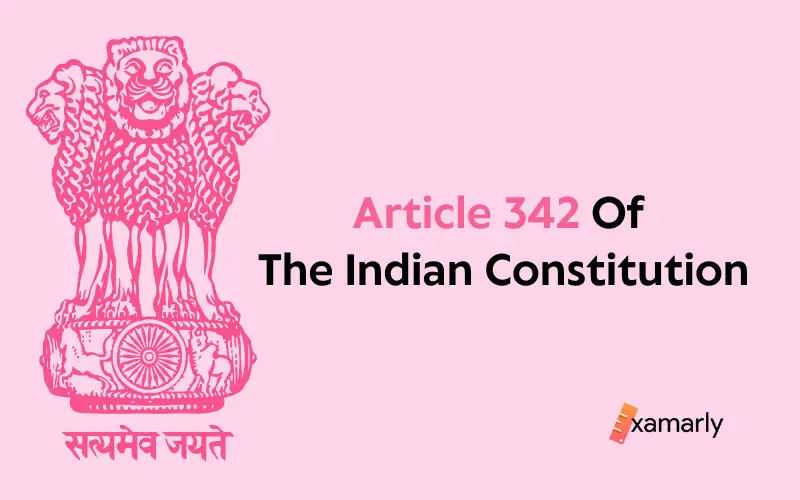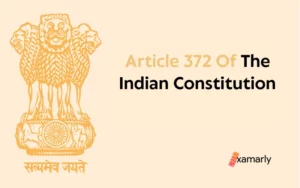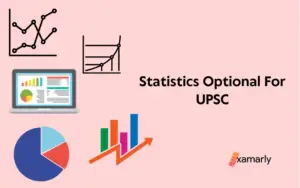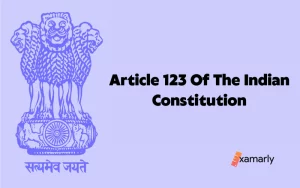Article 342 of the Indian Constitution explains the process for determining which tribes or communities are considered Scheduled Tribes.
The term “Scheduled Tribes” is defined in the Indian Constitution under Article 366 (25) as “tribes or tribal communities or parts of or groups within such tribes or tribal communities that are deemed under Article 342 to be Scheduled Tribes for the purposes of this constitution.”
In this blog, we are going to learn about the provisions that apply to the process of recognizing Scheduled Tribes in a State or Union Territory.
- Provisions of Article 342 Of The Indian Constitution
- Implications of Article 342 Of The Indian Constitution
- Article 342 Of The Indian Constitution – Scheduled Tribes
- Criticisms And Challenges Surrounding Article 342 Of The Indian Constitution
- Distribution Of Scheduled Tribes
- List Of The Constitution (Scheduled Tribes)
- Conclusion
- FAQs Related to Article 342 of the Indian Constitution
- Which part of the Constitution does Article 342 belong to?
- What is a tribe?
- What are Particularly Vulnerable Tribal Groups (PVTGs)?
- How many distinct tribes are there in India?
- Which Indian state has the largest tribal population?
- How are Scheduled Tribes determined?
- What are the criteria for inclusion in the list of Scheduled Tribes?
- What are the benefits of being recognized as a Scheduled Tribe?
- What are Scheduled Tribes?
- When was Article 342 added to the Constitution of India?
Provisions of Article 342 Of The Indian Constitution
- It allows the President of India to specify the tribes or tribal communities that are deemed to be Scheduled Tribes in relation to a state or Union Territory.
- The President must consult with the Governor of the state before issuing a notification.
- Parliament has the power to include or exclude any tribe or tribal community from the list of Scheduled Tribes specified in a notification.
- Once a notification is issued, it can be changed only through an Act of Parliament.
Implications of Article 342 Of The Indian Constitution
- It determines the eligibility of tribes or tribal communities for reservation of seats in the Legislative Assemblies.
- It aims to protect the rights and interests of Scheduled Tribes, who are socially and economically disadvantaged groups.
- It ensures their representation in the decision-making processes at the state level.
Article 342 Of The Indian Constitution – Scheduled Tribes
Let’s take a closer look at the clauses of Article 342 of the Indian Constitution for a comprehensive understanding.
Clause 1 – As it is & Explained
(1) The President 1 [may with respect to any State [or Union territory], and where it is a State, after consultation with the Governor thereof], by public notification, specify the tribes or tribal communities or parts of or groups within tribes or tribal communities which shall for the purposes of this Constitution be deemed to be Scheduled Tribes in relation to that State [or Union territory, as the case may be.]
The first clause of Article 342 of the Indian Constitution is related to the reservation of seats for Scheduled Tribes in the Legislative Assemblies of the states.
The provision gives the President of India the authority to specify the tribes or tribal communities that are considered to be Scheduled Tribes in relation to a particular state or Union Territory through a public notification. But the President is required to consult with the Governor of the state before issuing the notification.
Clause 2 – As it is & Explained
(2) Parliament may by law include in or exclude from the list of Scheduled Tribes specified in a notification issued under clause (1) any tribe or tribal community or part of or group within any tribe or tribal community, but save as aforesaid a notification issued under the said clause shall not be varied by any subsequent notification.
The second clause of Article 342 of the Indian Constitution talks about the role of the Parliament in the process of notifying Scheduled Tribes.
This provision allows Parliament to include or exclude any tribe or tribal community from the list of Scheduled Tribes specified in a notification issued by the President under the first clause of this article as explained above.
This means that Parliament has the power to add or remove a tribe or community from the list of Scheduled Tribes as it sees fit. This provision allows for flexibility in the determination of which tribes or communities are considered Scheduled Tribes but also ensures that the list is not constantly changing.
Criticisms And Challenges Surrounding Article 342 Of The Indian Constitution
- Some argue that the list of Scheduled Tribes may not accurately reflect the current social and economic status of all tribes.
- There have been instances of disputes over the inclusion or exclusion of certain tribes from the list.
Distribution Of Scheduled Tribes
The list of Scheduled Tribes belongs to a specific State or Union Territory and a community declared as a Scheduled Tribe in a State is not necessarily considered to be so in another State. The addition of a community as a Scheduled Tribe is an evolving process.
The common characteristics of these communities are:
- Primitive Traits
- Geographical isolation
- Distinct cultural practices
- Shy of contact with the community at large
- Economical backwardness
Tribal communities reside in various ecological and geo-climatic conditions ranging from plains and forests to hills and inaccessible areas. The stages of social, economic, and educational development differ from one Tribal group to another. While some tribal communities have adapted to a mainstream way of life, there are certain Scheduled Tribes at the other end of the spectrum, 75 of them known as Particularly Vulnerable Tribal Groups (PVTGs), who are distinguished by
- pre-agriculture level of technology
- stagnant or declining population
- extremely low literacy
- subsistence level of economy
According to the 2011 census, the Scheduled Tribes in India constitute 8.6% of the total population or approximately 10.43 crore people. These tribes are notified in 30 states and Union Territories, and there are 705 individual ethnic groups that are considered Scheduled Tribes.
The tribal population is primarily concentrated in two geographical areas: Central India and the North-Eastern region. More than half of the Scheduled Tribe population is located in Central India, with Madhya Pradesh, Chhattisgarh, Jharkhand, Andhra Pradesh, Maharashtra, Orissa, Gujarat, and Rajasthan having the highest concentration of Scheduled Tribes.
The North-Eastern region is also home to a significant population of Scheduled Tribes. Overall, more than two-thirds of the Scheduled Tribe population is concentrated in just seven states: Madhya Pradesh, Maharashtra, Orissa, Gujarat, Rajasthan, Jharkhand, and Chhattisgarh. There is no Scheduled Tribe population in Delhi NCR, Punjab, Haryana, Puducherry, or Chandigarh, as no tribes are notified in these states or Union Territories.
The decadal population growth rate of Scheduled Tribes from 2001 to 2011 was 23.66%, compared to 17.69% for the overall population. The sex ratio for the general population is 940 females per 1000 males, while the ratio for Scheduled Tribes is 990 females per 1000 males. The majority of the Scheduled Tribe population lives in rural areas (89.97%), while a small percentage lives in urban areas (10.03%).
List Of The Constitution (Scheduled Tribes)
Mentioned below is a list of the constitution (scheduled tribes) orders along with the date of notification as well as the states they were applicable to, for your reference
| S. No. | Name Of Order | Date Of Notification | Name Of States/ Ut(S) For Which Applicable |
|---|---|---|---|
| 1 | The Constitution (Scheduled Tribes) Order 1950 (C.O.22) | 6-9-1950 | Andhra Pradesh, Arunachal Pradesh, Assam, Bihar, Gujarat, Goa, Himachal Pradesh, Karnataka, Kerala, Madhya Pradesh, Maharashtra, Manipur, Meghalaya, Mizoram, Orissa, Rajasthan, Tamil Nadu, Tripura and West Bengal. |
| 2 | The Constitution (Scheduled Tribes) (Union Territories) Order, 1951 (C.O.33) | 20-9-1951 | Daman & Diu, Lakshadweep |
| 3 | The Constitution (Andaman And Nicobar Islands) Scheduled Tribes Order, 1959 (C.O. 58) | 31-3-1959 | Andaman And Nicobar Islands |
| 4 | The Constitution (Dadra & Nagar Haveli) Scheduled Tribes Order, 1962 (C.O. 65) | 30-6-1962 | Dadra & Nagar Haveli |
| 5 | The Constitution (Uttar Pradesh) Scheduled Tribes Order, 1967 (C.O. 78) | 24-6-1967 | Uttar Pradesh |
| 6 | The Constitution (Nagaland) Scheduled Tribes Order, 1970 (C.O.88) | 23-7-1970 | Nagaland |
| 7 | The Constitution (Sikkim) Scheduled Tribes Order, 1978 (C.O.111) | 22-6-1978 | Sikkim |
| 8 | The Constitution Scheduled Tribes Order (Amendment) Act, 1987 | 09.12.1987 | Meghalaya |
| 9 | The Constitution (Jammu & Kashmir) Scheduled Tribes Order, 1989 (C.O. 142) | 7-10-1989 | Jammu & Kashmir |
| 10 | The Constitution Scheduled Tribes Order (Amendment) Act, 1991 | 17.09.1991 | Jammu & Kashmir |
| 11 | The Constitution Scheduled Tribes Order (Amendment) Act, 2002 | 03.06.2002 | Madhya Pradesh and Maharashtra |
| 12 | The Constitution Scheduled Tribes Order (Amendment) Act, 2002 | 07.01.2003 | Andhra Pradesh, Arunachal Pradesh, Assam, Bihar, Goa, Gujarat, Himachal Pradesh, Jharkhand, Karnataka, Kerala, Madhya Pradesh, Maharashtra, Manipur, Mizoram, Orissa, Sikkim, Tamil Nadu, Tripura, Uttar Pradesh and West Bengal |
| 13 | The Constitution (Scheduled Tribes) Order (Amendment) Act, 2003 | 19.09. 2003 | Assam |
| 14 | The Constitution (Scheduled Tribes) Order (Amendment) Act, 2006 | 12.12. 2006 | Bihar |
| 15 | The Constitution (Scheduled Tribes) Order (Amendment) Act, 2008 | 01.04. 2008 | Arunachal Pradesh |
| 16 | The Constitution (Scheduled Tribes) Order(Amendment) Act, 2013 | 18.09.2013 | Kerala and Chhattisgarh |
| 17 | The Constitution (Puducherry) Scheduled Tribes Order, 1989 (C.O. 268) | 22.12.2016 | Puducherry |
Conclusion
From what we learned from Article 342 of the Indian Constitution, we can conclude that it deals with the provisions related to Scheduled Tribes and plays a crucial role in promoting the welfare and development of the Scheduled Tribes in India.
The President of India has the authority to specify the tribes or communities that are deemed to be Scheduled Tribes in relation to a particular state or Union Territory through a notified order, following consultation with the state governments concerned. These orders can only be modified subsequently through an Act of Parliament. The provision also allows the listing of Scheduled Tribes to be done on a state or Union Territory basis, rather than at the national level.
You might also like to read – Article 341 Of The Indian Constitution
FAQs Related to Article 342 of the Indian Constitution
Which part of the Constitution does Article 342 belong to?
Article 342 of the Indian Constitution belongs to Part XVI which is called “Special provisions relating to certain classes”.
What is a tribe?
A “tribe” is a social division in a traditional society that consists of families connected by blood, economic, social, or religious ties, with a common culture and dialect. Tribes possess certain qualities and traits that make them unique cultural, social, and political entities. In India, Tribes are also known as ‘Adivasis’.
What are Particularly Vulnerable Tribal Groups (PVTGs)?
PVTGs are the more vulnerable tribal groups with a declining or stagnant population, low literacy level, and a pre-agricultural level of technology. They usually inhabit remote localities with poor infrastructure and administrative support and are economically backward. As many as 75 tribal groups have been recognized by the Ministry of Home Affairs as Particularly Vulnerable Tribal Groups (PVTG)s.
How many distinct tribes are there in India?
705 ethnic groups are recognized as Scheduled Tribes in India. They are termed “Adivasis” which means Indigenous People and comprise 8.6% of the total population which is approximately 104 million.
Which Indian state has the largest tribal population?
Madhya Pradesh tops the list in Tribal Population followed by Odisha.
How are Scheduled Tribes determined?
The President of India has the authority to specify the tribes or communities that are deemed to be Scheduled Tribes in relation to a particular state or Union Territory through a notified order, following consultation with the state governments concerned. These orders can be modified subsequently only through an Act of Parliament. The list of Scheduled Tribes for each state or Union Territory is notified based on these provisions and is only valid within the jurisdiction of that state or Union Territory.
What are the criteria for inclusion in the list of Scheduled Tribes?
The criteria for inclusion in the list of Scheduled Tribes are not specified in the Indian Constitution. However, the tribes or communities that are included in the list are generally considered to be socially and economically disadvantaged and in need of affirmative action measures such as reservation of seats in educational institutions and government employment.
What are the benefits of being recognized as a Scheduled Tribe?
Scheduled Tribes are eligible for affirmative action measures such as reservation of seats in educational institutions and government employment, as well as other welfare schemes and development programs. The purpose of these measures is to protect the rights and interests of Scheduled Tribes and promote their welfare and development.
What are Scheduled Tribes?
Scheduled Tribes are ethnic groups or communities that are considered to be socially and economically disadvantaged in India. They are recognized as such under the Indian Constitution and are eligible for affirmative action measures such as reservation of seats in educational institutions and government employment.
When was Article 342 added to the Constitution of India?
Draft Article 300B (Article 342 of the Constitution of India 1950) was absent in the Draft Constitution 1948 and was added to the Constitution on 17 September 1949. It was amended in 1956 to modify the process of notification issued by the President of India.






